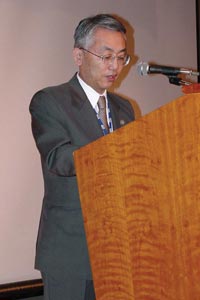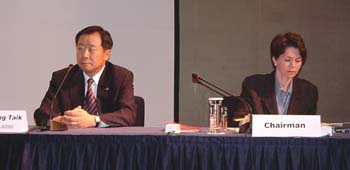|

ITU 020101/Eyewire
|
CREATING TRUST IN CRITICAL NETWORK INFRASTRUCTURES
Just how secure are our networks?
|

ITU 020133/Yong-Hwan Lee, TTA
As more and more information is
exchanged over electronic networks, they become an increasingly interesting
target for malicious intrusions...
|
World Cup 2002 is in its quarter-final stage as we
write these lines. It is an exciting moment for those who win, and their fans.
The World Cup is probably the biggest single global media event, with billions
watching on television, listening to the radio, or following the results on the
Internet. In the two host countries for World Cup 2002, the Republic of Korea
and Japan, the main concern before and during that event is for physical
security.
For football fans around the world, the
main concern must surely be the reliability of the networks that broadcast the
World Cup so that they can share in those moments of emotion, great joy, or
disappointment.
“As more and more information is
exchanged over electronic networks, they become an increasingly interesting
target for malicious intrusions. On the Internet, viruses and denial of service
attacks are becoming more common and virulent every day. As mobile phones become
a key means of communicating, they are also vulnerable to eavesdropping,” ITU
Secretary-General, Yoshio Utsumi, told participants at an ITU Strategic Planning
Workshop, held in Seoul at the invitation of the Government of the Republic of
Korea.
“Creating Trust in Critical Network
Infrastructures” was the topic of the Seoul meeting (20–22 May 2002),
which marked the eighth in a series of expert workshops carried out under the
ITU New Initiatives Programme* that has been running since 1999.
The event was intended to complement a
technical workshop on “Network Security”, also held in Seoul a week earlier
by the ITU Telecommunication Standardization Sector (ITU–T). ITU has
considerable technical expertise in many of the areas concerned by the security
of info-communication networks, such as traditional telephone networks, mobile
telephony and IP technology, as well as broadcasting networks .
Holding workshops away from ITU’s
Geneva headquarters, at the invitation of Member States, brings ITU closer to
the direct interests of its membership. The main objective of this Strategic
Planning Workshop was to provide a forum for both Member States and the private
sector to discuss the protection of critical network infrastructures from policy
and regulatory perspectives. A further aim was to promote the international
exchange of views and information, as well as to share experiences
internationally.
|
* One of the main objectives of the ITU
New Initiatives Programme is to advise the Secretary-General on new topics of a
regulatory, policy or other nature of high-current interest, which cut across
the work of the ITU Sectors, with a view to possible inclusion of these topics
in the regular work programme of the Union. This work is reported on annually to
the ITU Council, the Union’s governing body. The topics of the workshops are
selected by the Secretary-General in consultation with Member States and Sector
Members.
Recent events have covered the topics
of multilingual domain names, Internet diffusion, IP connectivity and the
licensing of third-generation mobile communication systems. This work has been
supported by voluntary contributions, for instance from the Ministry of
Information and Communication of the Republic of Korea and from the Ministry of
Public Management, Home Affairs, Posts and Telecommunications of Japan. This
assistance has enabled ITU to commission research and to create forums for its
membership to examine issues of high-current international policy interest.
|
Mr Utsumi remarked that the global
reach of communication networks had resulted in a huge increase in cybercrimes
of an international nature. “Vandals and criminals are no longer restricted to
a single geographic location. A hacker in one country can attack a network in
another country, using tools — such as user accounts — from a third country.
To counter such international threats to our information security, greater
international coordination and cooperation is needed”, he remarked.
|

ITU 020104/PhotoDisc
|
Mr Utsumi went on to explain that the
longer-established telecommunication community “has long had to deal with
these issues” and that “generally, there are reliable security standards and
procedures already in place”. He added: “The Internet, however, has gone
through a less formal growth process. When problems occur in the infrastructure
underlying critical applications, the Internet’s vulnerabilities are made
evident. Similarly, as mobile networks are increasingly used for data
communications as well as voice, a whole new set of security issues is arising.”
Seung Taik Yang, Minister of
Information and Communication (Republic of Korea), remarked that the tremendous
benefits of the Internet we are enjoying come at a price. “We are experiencing
a rapid increase in spam mails, hacking and computer viruses brought into our
lives through informatization. What is more serious is that the hostile
cyberattacks on our critical network infrastructure are not only threatening the
social and economic stability, but are also putting national security in danger,”
he said.
|
ITU 020109/Yong-Hwan Lee, TTA
From
left to right: Seung Taik Yang, Minister of Information and Communication,
Republic of Korea; and Professor Deborah Hurley of the Harvard University
Information Infrastructure Project (United States) chairing the ITU Strategic
Planning Workshop.
For the purposes of the workshop,
critical network infrastructures were defined as those networks, public or
private, capable of transporting large quantities of data across international
borders and which carry information relevant to national security and safety or
information of high financial value
|
“Nations worldwide, aware of the
seriousness of these problems, have been making a significant effort to enact
laws and regulation, and to develop technologies in order to protect themselves
from this cyberterrorism,” he told participants, adding that the Republic of
Korea was no exception.
Indeed, the Republic of Korea has
enacted the “Information Communication Infrastructure Protection Act”, which
requires mandatory protection measures for the critical network infrastructure
as designated by the government. It has also established an “Anti-Hacking and
Virus Reporting Centre”, where incidents of hacking and viruses can be
reported round-the-clock.
“But such attacks in cyberspace often
go beyond nations’ boundaries and that is why, on top of the unilateral effort
by each nation to counter cyberterrorism, nations should also put a top priority
to a cooperative effort such as joint development of information security
technologies and sharing information gained through experience. In this sense,
it is obvious that international cooperation is one of the most effective ways
to solve such a problem,” added the Minister.
Some 70 security experts participated
in the workshop, acting in an individual capacity, including representatives of
a range of regulatory and policy-making agencies, public telecommunication
operators, private sector bodies, academic institutions and others. Professor
Deborah Hurley of the Harvard University Information Infrastructure Project
(United States) chaired the workshop.
What exactly do we mean by critical network
infrastructures?
For the purposes of the workshop,
critical network infrastructures were defined as those networks, public or
private, capable of transporting large quantities of data across international
borders and which carry information relevant to national security and safety or
information of high financial value.
|
ITU 020108/EyeWire
Where are the weak links?
|
Some of the questions posed for the
workshop included:
-
Is there anything about the
architecture of the Internet that makes it more or less vulnerable when
compared to other info-communication networks? Where are the weak links?
-
If vulnerabilities continue to
emerge, what are the costs in terms of users’ loss of confidence?
-
How do we increase global awareness
of the issues?
-
Do we need active global security
monitoring?
-
Is securing network infrastructure
a technology or policy problem — or a combination of both?
-
Do we need an integrated risk
management strategy involving prevention, detection, monitoring and
response? If so, what are the respective roles of the private sector and
government?
-
In a world of intertwined global
networks, is there a need for a coordinated, sustained and institutionalized
approach to protecting critical network infrastructure?
-
How can ITU help its membership in
gaining access to the information required to respond to these challenges?
Three background issues documents were
prepared in advance and were presented and discussed during the workshop. These
dealt with:
In addition, a number of country case
studies were commissioned, covering Brazil, Canada, the Republic of Korea and
the Netherlands**. These were discussed along with the experiences of other
countries and regional groups, notably India, Japan, Kenya, Malaysia and the
Association of South East Asian Nations (ASEAN).
The Chairman’s Report and the POLICY AND STRATEGY TRENDS
highlight the discussions and conclusions of the workshop.
|
**
These case studies are available on the ITU website:
|
|